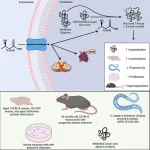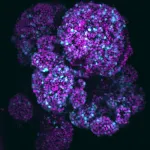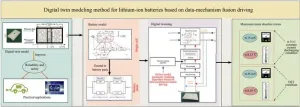(Press-News.org) Ketone bodies, produced by the body to provide fuel during fasting, have roles in regulating cellular processes and aging mechanisms beyond energy production. Research at the Buck Institute shows that ketone bodies can best be understood as powerful signaling metabolites affecting brain function in aging and Alzheimer’s disease. A new study demonstrates that ketone bodies and similar metabolites have profound effects on the proteome and protein quality control in the brain. Publishing in Cell Chemical Biology, Buck Institute scientists, working in mouse models of Alzheimer’s disease and aging, and in the nematode C. elegans, reveal the ketone body β-hydroxybutyrate interacts directly with misfolded proteins, altering their solubility and structure so they can be cleared from the brain through the process of autophagy.
Previous studies have shown that boosting ketone bodies through diet, exercise and supplementation can be good for brain health and cognition, both in rodents and humans. Senior author John Newman, MD, PhD, an assistant professor at the Buck, says many theorized that the ketone body-based improvements were caused by increased energy to the brain or a reduction in brain inflammation, with reported improvements in amyloid plaques in mouse models being an indirect by-product. “Now we know that’s not the whole story,” he said. “Ketone bodies interact with damaged and misfolded proteins directly, making them insoluble so they can be pulled from the cell and recycled.”
While acknowledging that other mechanisms like energy supply are also important to brain health, Newman calls the discovery new biology. “It’s a new link between metabolism in general, ketone bodies and aging,” he said. “Directly linking changes in a cell’s metabolic state to changes in the proteome is really exciting.” Noting that ketone bodies are easy to manipulate experimentally and therapeutically, Newman adds, “This might be a powerful avenue to assist with global clearing of damaged proteins. We’re just scratching the surface as to how this might be applied to brain aging and neurodegenerative disease.”
In addition to testing the changing solubility and structure of proteins in test tubes, the project also involved feeding a ketone ester to mice to confirm that the test tube results were reproduced in the brain. In mice, the ketone ester treatment resulted in clearance rather than pathological aggregation of insoluble proteins.
The work also highlights the power of the Buck’s collaborative environment. The Schilling lab generated detailed proteome-wide solubility maps from both the test tube and mouse experiments. To test if the solubility changes caused by ketone bodies helped improve models of pathological aggregation, the Lithgow lab fed ketone bodies to tiny nematode worms that were genetically modified to express the human equivalent of amyloid beta, which causes amyloid plaques. “The amyloid beta affects muscles and paralyzes the worms,” says Sidharth Madhavan, a PhD candidate and lead author on the study. “Once they were treated with ketone bodies the animals recovered their ability to swim. It was really exciting to see such a dramatic impact in a whole animal.”
Madhavan is now pursuing whether ketone bodies and related metabolites have similar effects outside the brain, such as in the gut. A key next step will be to test this new protein quality control mechanism in people to help guide how best to apply it in therapies, he adds.
Newman says the study highlights a new form of metabolic regulation of protein quality control. “This is not just about ketone bodies,” he said. “We tested similar metabolites in test tubes and a bunch of them had similar effects. In some cases, they performed better than β-hydroxybutyrate. It’s beautiful to imagine that changing metabolism results in this symphony of molecules cooperating together to improve brain function.”
CITATION: B-hydroxybutyrate is a metabolic regulator of proteostasis in the aged and Alzheimer’s disease brain
DOI: /10.1016/j.chembiol.2024.11.001
Other Buck researchers involved in the study are Stephanie Roa Diaz, Sawyer Peralta, Mitsunori Nomura, Christina D. King, Kaya E. Ceyhan, Anwen Lin, Dipa Bhaumik, Anna C. Foulger, Samah Shah, Thanh Blade, Wyatt Gray, Manish Chamoli, Brenda Eap, Oishika Panda, Diego Diaz, Thelma Y. Garcia, Brianna J. Stubbs, Gordon J. Lithgow, Birgit Schilling, Eric Verdin, Asish R. Chaudhuri.
Acknowledgments: This work was supported by the National Institutes of Health (NIH R01AG067333, NIA T32AG052374, NIA T32 AG000266, NIH R01AG067333-02S1), a sponsored research agreement from BHB Therapeutics, University of Southern California Provost Fellowship Funding, the Larry L. Hillblom Foundation, and Buck Institute institutional funding.
COI: JCN and EV hold patents related to molecules described in the paper, licensed to BHB Therapeutics Ltd and Selah Therapeutics Ltd. JCN and EV are co-founders with stock holdings, and BJS hold stock options in BHB Therapeutics. JCN, EV and BS are co-founders with stock options in Selah Therapeutics.
About the Buck Institute for Research on Aging
At the Buck, we aim to end the threat of age-related diseases for this and future generations. We bring together the most capable and passionate scientists from a broad range of disciplines to study mechanisms of aging and to identify therapeutics that slow down aging. Our goal is to increase human health span, or the healthy years of life. Located just north of San Francisco, we are globally recognized as the pioneer and leader in efforts to target aging, the number one risk factor for serious diseases including Alzheimer’s, Parkinson’s, cancer, macular degeneration, heart disease, and diabetes. The Buck wants to help people live better longer. Our success will ultimately change healthcare. Learn more at: https://buckinstitute.org
END
Ketone bodies: more than energy, they are powerful signaling metabolites that clean up damaged proteins
Ketone esters help clear misfolded proteins in mouse models of aging and Alzheimer’s disease
2024-12-02
ELSE PRESS RELEASES FROM THIS DATE:
Implementation of electronic triggers to identify diagnostic errors in emergency departments
2024-12-02
About The Study: In this retrospective medical record review study, rules-based e-triggers were useful for post hoc detection of missed opportunities in diagnosis in emergency department visits. Interventions to target emergency department work system factors are urgently needed to support patient-clinician encounters and minimize harm from diagnostic errors.
Corresponding Author: To contact the corresponding author, Hardeep Singh, MD, MPH, email hardeeps@bcm.edu.
To access the embargoed study: ...
Characterizing services advertised on crisis pregnancy center websites
2024-12-02
About The Study: The findings of this study suggest the need for greater scrutiny of crisis pregnancy center practices, particularly their service provision, provider qualifications, and how these conform with regulations or best practices. A key concern is their promotion of abortion pill reversal, which lacks FDA approval or scientific support and may cause harm.
Corresponding Author: To contact the corresponding author, John W. Ayers, PhD, MA, email ayers.john.w@gmail.com.
To ...
Study of crisis pregnancy centers reveals misleading and dangerous claims
2024-12-02
La Jolla, Calif. (December 2, 2024) — A new study from scientists at the University of California San Diego introduces a powerful new approach to understanding the operation of crisis pregnancy centers, non-profit organizations dedicated to an anti-abortion agenda. The study published in JAMA Internal Medicine provides the first account of the practices of crisis pregnancy centers (CPC) operating in the United States.
"While our study shows crisis pregnancy centers provide valuable community services, like parenting classes, there is a clear need for consumer safety measures to prevent the promotion and use of their ...
Researchers deal a blow to theory that Venus once had liquid water on its surface
2024-12-02
A team of astronomers has found that Venus has never been habitable, despite decades of speculation that our closest planetary neighbour was once much more like Earth than it is today.
The researchers, from the University of Cambridge, studied the chemical composition of the Venusian atmosphere and inferred that its interior is too dry today for there ever to have been enough water for oceans to exist at its surface. Instead, the planet has likely been a scorching, inhospitable world for its entire history.
The results, reported in the journal Nature Astronomy, have implications for understanding Earth’s uniqueness, and for the search for life on planets outside ...
Photonic processor could enable ultrafast AI computations with extreme energy efficiency
2024-12-02
The deep neural network models that power today’s most demanding machine-learning applications have grown so large and complex that they are pushing the limits of traditional electronic computing hardware.
Photonic hardware, which can perform machine-learning computations with light, offers a faster and more energy-efficient alternative. However, there are some types of neural network computations that a photonic device can’t perform, requiring the use of off-chip electronics or other techniques that hamper speed and efficiency.
Building on a decade of research, scientists from ...
Researchers create a new organoid with all key pancreas cells
2024-12-02
Researchers from the Organoid group (previously Clevers group) at the Hubrecht Institute have developed a new organoid that mimics the human fetal pancreas, offering a clearer view of its early development. The researchers were able to recreate a complete structure that includes the three key cell types in the pancreas, which previous organoids couldn’t fully mimic. Notably, the team identified a new stem cell that develops into the three cell types. These findings, published in Cell ...
Stimulating hypothalamus restores walking in paralyzed patients
2024-12-02
Researchers at EPFL and Lausanne University Hospital (CHUV), led by professors Grégoire Courtine and Jocelyne Bloch, have achieved a major milestone in the treatment of spinal cord injuries (SCI). By applying deep brain stimulation (DBS) to an unexpected region in the brain—the lateral hypothalamus (LH)—the team has improved the recovery of lower limb movements in two individuals with partial SCI, greatly improving their autonomy and well-being.
Wolfgang Jäger, a 54-year-old from Kappel, Austria, has been in a wheelchair ...
Pioneering digital twin model elevates lithium-ion battery performance and safety
2024-12-02
Source: Beijing Institute of Technology Press
Lithium-ion batteries are celebrated for their high specific energy, long service life, and low self-discharge rates. However, ensuring their reliability and safety under various operating conditions is critical for their continued success in industrial applications. Digital twin technology, which creates a virtual replica of a physical entity, offers a promising solution by enabling real-time monitoring and optimization of battery performance. This technology facilitates interactive feedback, data fusion, and iterative ...
A breakthrough in battery capacity degradation analysis and knee point prediction
2024-12-02
Analyzing capacity degradation characteristics and accurately predicting the knee point of capacity are crucial for the safety management of lithium-ion batteries (LIBs). A recent breakthrough study presented by researchers from Shandong University introduces a knee point prediction method based on neural network. This advanced method can help us clarify the degradation mechanism and predict the knee point.
The study focuses on battery life, which is the result of multiple coupling aging mechanisms affected by multiple factors. It is significantly necessary to clarify the mechanism for the capacity degradation at each stage and possess the ability to detect the knee point. It can not only ...
Newfound mechanism may explain why some cancer treatments boost risk of heart disease
2024-12-02
A cancer therapy that prompts the body’s immune defenses against viruses and bacteria to attack tumors can make patients more vulnerable to heart attack and stroke. A possible explanation for this side effect is that the treatment interferes with immune regulation in the heart’s largest blood vessels, a new study suggests.
Led by researchers at NYU Langone Health and its Perlmutter Cancer Center, the new work focused on a potent class of cancer-fighting drugs called immune checkpoint inhibitors. These medications ...
LAST 30 PRESS RELEASES:
University of Oklahoma researcher awarded funding to pursue AI-powered material design
Exploring how the visual system recovers following injury
Support for parents with infants at pediatric check-ups leads to better reading and math skills in elementary school
Kids’ behavioral health is a growing share of family health costs
Day & night: Cancer disrupts the brain’s natural rhythm
COVID-19 vaccination significantly reduces risk to pregnant women and baby
The role of vaccination in maternal and perinatal outcomes associated with COVID-19 in pregnancy
Mayo Clinic smartwatch system helps parents shorten and defuse children's severe tantrums early
Behavioral health spending spikes to 40% of all children’s health expenditures, nearly doubling in a decade
Digital cognitive behavioral treatment for generalized anxiety disorder
Expenditures for pediatric behavioral health care over time and estimated family financial burden
Air conditioning in nursing homes and mortality during extreme heat
The Alps to lose a record number of glaciers in the next decade
What makes a good proton conductor?
New science reporting guide published for journalists in Bulgaria
New international study reveals major survival gaps among children with cancer
New science reporting guide published for journalists in Turkey
Scientists develop a smarter mRNA therapy that knows which cells to target
Neuroanatomy-informed brain–machine hybrid intelligence for robust acoustic target detection
Eight SwRI hydrogen projects funded by ENERGYWERX
The Lundquist Institute and its start-up company Vitalex Biosciences Announces Strategic Advancement of Second-Generation fungal Vaccine VXV-01 through Phase 1 Trials under $40 Million Competitive Con
Fine particles in pollution are associated with early signs of autoimmune disease
Review article | Towards a Global Ground-Based Earth Observatory (GGBEO): Leveraging existing systems and networks
Penn and UMich create world’s smallest programmable, autonomous robots
Cleveland researchers launch first major study to address ‘hidden performance killer’ in athletes
To connect across politics, try saying what you oppose
Modulating key interaction prevents virus from entering cells
Project explores barriers to NHS career progression facing international medical graduates
Jeonbuk National University researchers explore the impact of different seasonings on the flavor perception of Doenjang soup
Two Keck Medicine of USC Hospitals named Leapfrog Top Teaching Hospitals
[Press-News.org] Ketone bodies: more than energy, they are powerful signaling metabolites that clean up damaged proteinsKetone esters help clear misfolded proteins in mouse models of aging and Alzheimer’s disease




